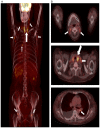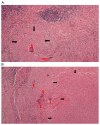Lymph node tuberculosis mimicking malignancy on 18F-FDG PET/CT in two patients: A case report
- PMID: 28587415
- PMCID: PMC5450601
- DOI: 10.3892/etm.2017.4421
Lymph node tuberculosis mimicking malignancy on 18F-FDG PET/CT in two patients: A case report
Abstract
18F-fluorodeoxyglucose positron emission/computed tomography (18F-FDG PET/CT) imaging, an established procedure for evaluation of malignancy, reports an increased 18F-FDG uptake in acute or chronic inflammatory condition. Lymph node tuberculosis (LNTB) is the most common form of extrapulmonary tuberculosis. However, the absence of clinical symptoms and bacteriological basis makes it difficult to diagnose. In the current case report, two patients with LNTB mimicking malignant lymphoma are presented by 18F-FDG PET/CT. The objective of the present report is to emphasize that LNTB should be considered as a noteworthy differential diagnosis in patients with enlarged lymph nodes, particularly in tuberculosis-endemic countries, and that lymph node biopsy serves a vital role in diagnosing LNTB.
Keywords: false positive; lymph node tuberculosis; malignancy; positron emission/computed tomography.
Figures




References
-
- Metser U, Even-Sapir E. Increased (18)F-fluorodeoxyglucose uptake in benign, nonphysiologic lesions found on whole-body positron emission tomography/computed tomography (PET/CT): Accumulated data from four years of experience with PET/CT. Semin Nucl Med. 2007;37:206–222. doi: 10.1053/j.semnuclmed.2007.01.001. - DOI - PubMed
-
- Burdick MJ, Stephans KL, Reddy CA, Djemil T, Srinivas SM, Videtic GM. Maximum standardized uptake value from staging FDG-PET/CT does not predict treatment outcome for early-stage non-small-cell lung cancer treated with stereotactic body radiotherapy. Int J Radiat Oncol Biol Phys. 2010;78:1033–1039. doi: 10.1016/j.ijrobp.2009.09.081. - DOI - PubMed
LinkOut - more resources
Full Text Sources
Other Literature Sources
